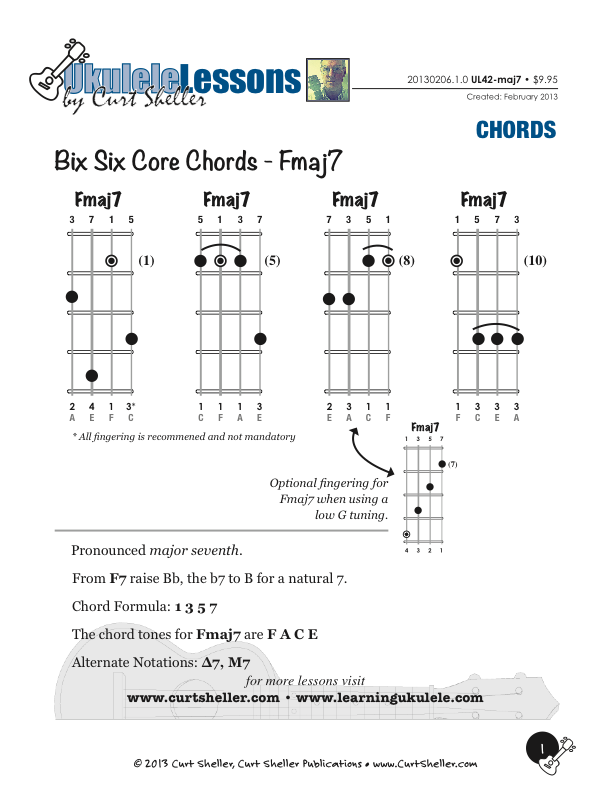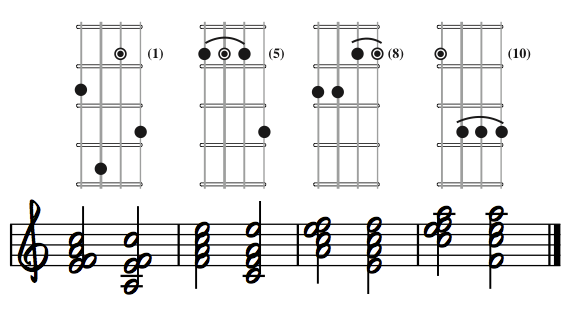The Big Six Core Chords, Level I - Fmaj7, four voicings. Fmaj7 is a 1 3 5 7 of the major scale, based on the root of the chord. These are the four Fmaj7 chord voicings that will be used for deriving other major seventh derived chords. There are far too many chord shapes to memorize thousands of shapes.




The Big Six Core Chords, Level I - Fmaj7, four voicings. Fmaj7 is a 1 3 5 7 of the major scale, based on the root of the chord.
Available for Premium Site Access Plans Only
These are the four Fmaj7 chord voicings that will be used for deriving other major seventh derived chords. There are far too many chord shapes to memorize thousands of shapes.
Why Do Some Chords Not Sound Right?
A very good question and very easy to answer and demonstrate. The next time your near a piano play any two adjacent white keys white keys without any black key between. Your either playing E and F or B and C. The interval between these adjacent pair of notes is a minor second or one half step apart and one of the more dissonant intervals in music. I call it the secret agent interval — very mysterious and can't be ignored. Not play one of the notes an octave higher of lower and you'll hear that it's not as bad.
Checkout the Song, The Pink Panther Theme for how effective the minor second is for conveying emotional quality of the minor second.
So anytime there is a note that is one half step or a minor second above or below any note in the chord there will be dissonance. Dissonance is good but not not in this case of the maj7 chord and the first voicing of the Fmaj7 in this lesson - the F on string three is one half step higher then the E on string two fret one.
By knowing the notes of a chord and where they are in relationship to each other can help avoid this problem before you play a chord that has the potential for this minor second dissonance.
The Big Six Core Chords, Level I - Fmaj7, four voicings. Fmaj7 is a 1 3 5 7 of the major scale, based on the root of the chord.
Available for Premium Site Access Plans Only
These are the four Fmaj7 chord voicings that will be used for deriving other major seventh derived chords. There are far too many chord shapes to memorize thousands of shapes.
Why Do Some Chords Not Sound Right?
A very good question and very easy to answer and demonstrate. The next time your near a piano play any two adjacent white keys white keys without any black key between. Your either playing E and F or B and C. The interval between these adjacent pair of notes is a minor second or one half step apart and one of the more dissonant intervals in music. I call it the secret agent interval — very mysterious and can't be ignored. Not play one of the notes an octave higher of lower and you'll hear that it's not as bad.
Checkout the Song, The Pink Panther Theme for how effective the minor second is for conveying emotional quality of the minor second.
So anytime there is a note that is one half step or a minor second above or below any note in the chord there will be dissonance. Dissonance is good but not not in this case of the maj7 chord and the first voicing of the Fmaj7 in this lesson - the F on string three is one half step higher then the E on string two fret one.
By knowing the notes of a chord and where they are in relationship to each other can help avoid this problem before you play a chord that has the potential for this minor second dissonance.
The Big Six Core Chords - Fmaj7, Four Voicings
The maj7 chord is one of your Big Six Core Chords and Fmaj7 is the notes: F A C E. Actually pretty easy one to memorize as it a real word that we all know and is the spaces of the five line music staff in the treble or G clef. When the notes of the chord are shown on standard music notation you can easily see where the dissonance happens. Here are the four chords shown in both high and log G, C tuning.

Notice that only one of the low G, C tuning voicings has the minor second interval problem. Where as three of the high G, C tuning voicings has the minor second interval problem.
Ukulele players using both a low or high G, C tuning will typically use this alternate voicing for first Fmaj7 voicing.

Voice Leading
When the first maj7 voicing, in this case the Fmaj7 above is properly set up with voice leading — voice leading is that common tones between chords remain and non-common tones move to closet note of the next chord - is actually sounds pretty nice. Try this Gm7 C7 to Fmaj7 and hear just how sweet it sounds.

Related Lessons, Videos, Lesson Series, Songs, Books & Reference Charts, Resources & Assets, Workshops are below.

The Big Six Core Chords is a series of lessons for building your core, essential 4-part chords. These chords commonly called jazz chords, are really just 4-part chords used in a wide range of musical styles. These chords include: Seventh , Major Seventh, Minor Seventh, Half Diminished Seventh or Minor Seven Flat Five, Diminished Seventh, and Augmented Seventh. These six chords form a core set of chords.

"Transposition" is the process of moving a note, chord, scale or any musical passage from one key to another key. All music can be transposed, from a single note to a complex musical score. This lesson deals with transposing chords on ukulele and transposing chords.

In music, it is important to learn and recognize the key signature for C Major and A Minor. These two keys have corresponding major and natural minor scales, along with basic ukulele chords that can be used with each scale. The key of C Major, also known as the learning key, is particularly easy to memorize and start using.

Core Chords for Ukulele, The Big Six - From four F7 chord voicings or shapes, your can build your massive 4-part, a.k.a., “jazz” chord vocabulary. Beyond basic open position chords, basic movable form chords and a core set of 4-part chords. There are just too many chords shapes too memorize.

Beyond learning basic Ukulele chords, most players struggle with advanced chords. Commonly called "jazz" chords, these more sophisticated voicings find a wide use in all forms of music. A Guide to Advanced Chords for Ukulele - presents a highly organized and efficient approach to the mysterious subject of advanced chords. Chord dictionaries are not the answer.

Exploring jazz chords using a variety of common chord progressions based on songs from the standard jazz repertoire. Core Chords are the basic set of chords needed to play a wide range of music, in a variety of styles. This set of chords includes basic open position chords, basic movable form chords and the core 4-part "jazz" chords.

Finally, learn the names of the notes of the ukulele fingerboard in C tuning .

Learn the six fingering principles to navigating the ukulele fingerboard. Fingering is one of the most universal topics. Book: Six Secrets of the Ukulele Fingering

Harmonic Analysis is the understanding of the functional sequence of chords. It is the process used to analyze the harmonic structure of a progression, song or composition. Book: Harmonic Analysis for Scale Selection and Chord Substitution

Learn to read single note melodies in the first/open position is a lot easier than you might think. Book: Ukulele – Reading Music Series – Primer

An organized collection of daily practice and reference material for the contemporary ukulele player for developing the vocabulary and knowledge necessary for single note playing. Book: Daily Practice Material for the Contemporary Ukulele
Checkout the Books & Reference Charts for additional Handy, Dandy Reference Charts.

Ukulele Fingerboard Chart for C Tuning, Low or High G – G C E A

Ukulele Fingerboard Chart for G Tuning, Low or High A – D G B E

A handy reference chart of all 15 major and relative minor key signatures. US Letter 8.5 x 11 sized (ANSI-A), A4
Checkout the Books & Reference Charts for additional Handy, Dandy Reference Charts.









.jpg)